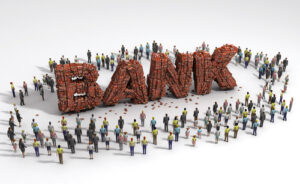Are you aware of the looming private debt crisis that is affecting the Build Back Better nations? The US government debt has reached an alarming 122.3% of the nation’s GDP in 2023, a burden that will ultimately fall on the taxpayers. As of Q1 2024, US household debt has skyrocketed to $1.77 trillion, with $12.44 trillion in mortgage debt, $1.62 trillion in auto loans, $1.12 trillion in credit card debt, and $543 billion in other forms of debt. Surprisingly, the average household debt stood at around $147,500 by the end of 2024. This rise in debt is evident in the increasing mortgage prices and auto debts, with more consumers relying on credit for basic necessities. Unfortunately, major banks across the US are now facing a crisis as Americans struggle to repay their debts.
Big players like Citigroup, Goldman Sachs, and Bank of America have collectively reported a staggering loss of $4,139,000,000 due to customers defaulting on their payments. The Federal Reserve Bank of New York had already issued a warning in May, citing the alarming signals from US household debt data. The total US household debt hit $17.69 trillion in Q1 2024, showing a worrying $640 billion increase in debt on an annual basis.
It’s crucial to understand that this debt crisis is not limited to a particular socioeconomic group. Even the affluent consumers are feeling the strain, with many resorting to credit to sustain their lifestyles. In fact, Citigroup CEO Jane Fraser pointed out that current spending and growth areas are largely driven by affluent customers, highlighting the pervasive nature of the issue. The St. Louis Fed’s data revealed a significant rise in credit card delinquencies, particularly in the top 10% of ZIP codes with wealth concentration.
As the debt crisis escalates, banks like JPMorgan Chase, Wells Fargo, and Goldman Sachs are struggling to collect their dues. JPMorgan Chase reported an unrecovered debt of $2.2 billion in the last quarter, Wells Fargo faced a shortfall of $1.3 billion, and Goldman Sachs saw their net charge-offs skyrocket to $359 million.
So, what happens when consumers can’t repay their debts? Banks may resort to various measures such as repossessing assets, taking legal action, or selling off the debt to collections agencies. This can have serious consequences on the consumer’s credit rating and their ability to secure future loans or financial support, trapping them in a vicious cycle of debt.
As bankruptcies rise and people struggle to meet their financial obligations, it’s evident that the debt crisis is impacting a wide range of individuals, including the upper-middle class. These individuals, often considered financially stable, are also experiencing challenges in managing their debts, indicating the gravity of the situation.
At Extreme Investor Network, we emphasize the importance of staying informed about economic trends and potential risks to your financial well-being. Our analysis goes beyond the surface to provide you with in-depth insights and strategies to navigate uncertain times. Stay ahead of the curve and make informed investment decisions with us.

